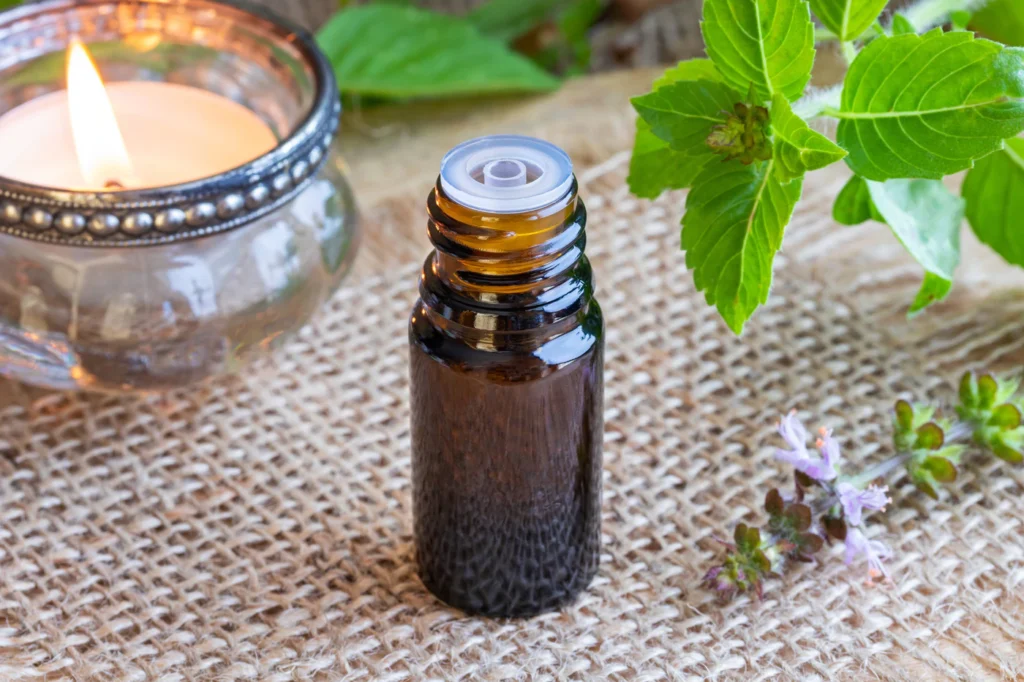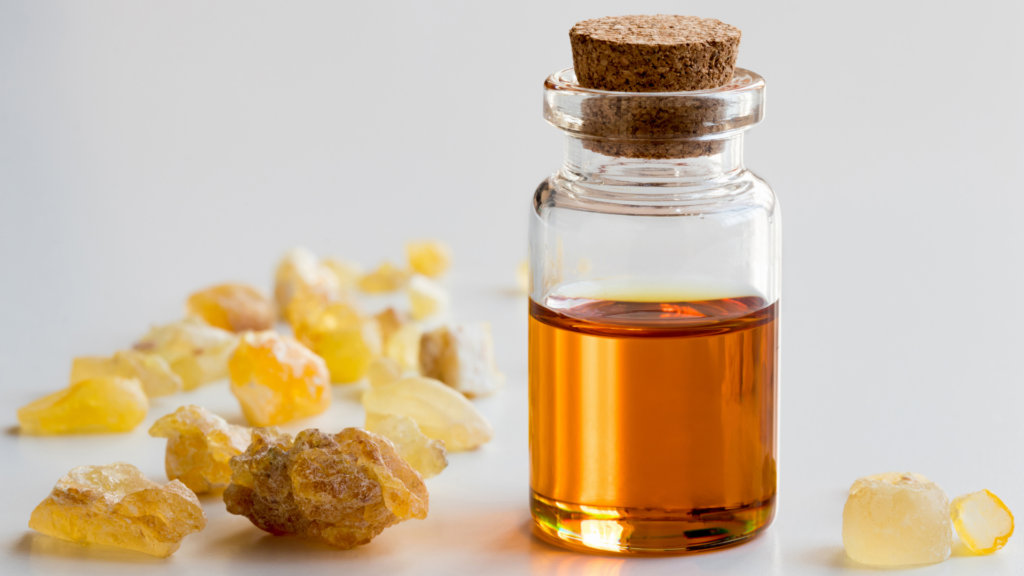Fever is a temporary rise in body temperature. [1, 2]
You have a fever if your body temperature goes above 37.5 degrees C (99.5 degrees F) [3].
Contrary to popular belief, it is not an illness but is actually a symptom.
Fever may be a good thing. It is the body’s way of fighting off bacteria and viruses that cause infections inside the body [4].
When you have a fever, it means that the body is trying to combat some infectious diseases. These diseases can be a common cold, flu, cough, tonsillitis, ear infection, chickenpox, urinary tract infection, etc. [7, 8].
Using essential oils for fever may lower your excessive body temperature. Apart from the rise in body temperature, the fever has other accompanying symptoms including chills, sweating, headache, and muscle pain [5].
These therapeutic oils may relieve other related symptoms of fever as well.
Read on to learn more about the benefits and uses of essential oils for fever relief.
Essential Oils for Fever: How Effective?
Fever takes place in the hypothalamus (body’s thermostat) of the brain. This part of the brain is in charge of regulating the body temperature [6].
Your body temperature will go down immediately once you’ve resolved the cause of the fever.
Many essential oils have anti-inflammatory and analgesic properties. These potent therapeutic components may lower fever and other symptoms.
Researchers claim that these oils are both safe and effective to treat fever at home.
Lowering fever will make you less prone to having a febrile seizure. The oils may make you feel calm and peaceful.
1. Holy Basil Oil
One of the quickest and most effective ways to reduce fever is with holy basil.
Several studies have proved that holy basil has potent antipyretic properties [9, 10].
Indian researchers claim that holy basil may reduce fever due to typhoid and diarrhea [9].
They also confirm holy basil’s anti-inflammatory actions for chronic inflammation [9].
The ability of this herb to lower body temperature is similar to that of aspirin. But the difference is that in holy basil, there are no adverse effects even after long-term use [10].
You may use this remedy for a long time, and you don’t have to worry about putting your health at risk [10].
Moreover, it is a proven antibacterial agent. It may kill infection-causing microbes, which may be a possible reason for the fever [11].
How to use basil oil for fever relief:
Blend 5 drops of holy basil oil with 1 teaspoon of jojoba oil in a glass jar. Cover the jar with its lid. Shake to mix. Put a few drops on the back of your neck and on the bottom of your feet. Repeat remedy three times a day for three to five days.
2. Peppermint Oil
The oil of peppermint comes from a perennial herb that belongs to the Labiatae family [12].
It is usually colorless but with a tinge of yellowish or greenish-yellow hue [12].
The most popular use of this medicinal oil is for treating irritable bowel syndrome. [13, 14, 15].
This isn’t all that it could do.
Peppermint’s cooling properties are also useful for toning down a fever [16].
Scientific research proves its significant antipyretic activities [17].
How to use peppermint oil for fever treatment:
Pour 5 drops of peppermint oil on a cold towel. Put the cold towel on the back of your neck.
Repeat several times a day until the temperature drops.
Also Read: 8 Reasons to Use Peppermint Oil for Hair
3. Spearmint Oil
It’s an aromatic herb commonly used in cosmetic and pharmaceutical products. Spearmint is best known for its stimulant and carminative properties [18].
Its oil originates from its leaves using a distillation process [18].
The extract has potent antiviral and antibacterial mechanisms [18].
It’s no wonder spearmint is also commonly used for treating a fever.
It kills the pathogens that may be causing the infection and the rise in body temperature [19].
In addition, it may also help reduce fever as well as ease pain and inflammation, according to a 2013 study [19].
How you may use spearmint oil for fever relief:
Put ice cubes in a bowl of water. Add 5 drops of spearmint oil to the cold water Soak a clean cloth into the water. Wring it to squeeze excess water.
Gently press the towel on warm areas of the body such as the armpits and the back of the neck. Follow this technique three to four times a day until the fever goes away.
4. Clove Oil
Clove is a member of the Myrtaceae family. It contains phenolics, monoterpenes, and other substances. These components produce antioxidant, antibacterial, and antifungal effects, among many others [20].
It may help fight a wide range of ailments.
It’s no surprise that many folk healers turn to clove for treating their ill patients.
The main compound in clove is eugenol, which makes up 70 to 85 percent of its oil extract [20].
Eugenol has a strong antipyretic, something that can be of great use for you if you’re suffering from fever [21].
It works in the same way as common medications prescribed for fever such as acetaminophen. But the good thing about this natural approach is that it’s without adverse effects [21].
How to use clove oil for treating fever:
Add 5 drops of clove oil to the cold towel. Put a cold towel on your forehead. Do this throughout the day, replacing the towel with a new one every half hour.
5. Frankincense Oil
Some people would let fever resolve on its own.
Those who cannot tolerate the unpleasantness of fever may get relief from frankincense.
Frankincense is popular for its wide array of benefits for health.
In fact, people have been using it since time immemorial to treat numerous health issues.
As it turns out, frankincense oil is one of the best essential oils for fever in children [22].
Many parents attest that their children felt better with frankincense treatment. There have been rare reports about adverse effects linked to the use of this oil.
Plus, there is sufficient evidence that frankincense has analgesic and anti-inflammatory actions.
Frankincense oil can tone down the swelling of viral or bacterial infection [23, 24].
Frankincense oil home remedy for fever:
Add 5 drops of frankincense oil to cold water. Give yourself a sponge bath using this mixture. Do this three times a day for up to one week.
Also Read: 12 Health Benefits and Uses of Frankincense Oil
6. Eucalyptus Oil
India is the “botanical garden of the world”. It is the biggest producer of medicinal plants [25].
Eucalyptus is one of the most popular Indian herbs for treating many illnesses [25].
We all love eucalyptus for its minty aroma and cooling effect on the skin.
It’s also popular as a tool for relaxation, which is why aromatherapists often make use of this oil.
As if all these are not enough, eucalyptus is also an antipyretic [25].
It may lower the body temperature and provide you with the comfort that you’ve been looking for.
This oil also possesses analgesic and anti-inflammatory properties. These compounds may help alleviate symptoms that usually come with fever [26].
Method of using eucalyptus essential oil for fever relief:
Dissolve 3 drops of eucalyptus oil and 2 drops of lavender oil in a bowl of cold water. Soak a cloth. Squeeze out excess water. Put the cloth on top of your forehead. Soak again in water after a few minutes. Repeat the procedure three times a day for one week.
7. Sandalwood Oil
Another effective way to alleviate fever is with sandalwood oil.
Sandalwood is a traditional Indian herb. It has potent antipyretic and sedative activities [25, 27].
Sandalwood has the ability to tone down the temperature of the body. At the same time, it may ease pain and discomfort.
That’s not all. Recent studies have shown sandalwood oil has astringent and fever-reducing effects [28].
In addition, it’s also an antibacterial that may combat one possible cause of fever [28].
How to use sandalwood oil for fever treatment at home:
Add 2 drops of sandalwood oil to 1 tablespoon of olive oil in a glass jar. Shake to blend. Apply a small amount to the forehead, temples, and feet. Repeat several times a day until you get relief.
8. Lavender Oil
Many people rely on lavender for alleviating anxiety and stress.
It may immediately soothe the nerves, relax the mind and make you forget all about stress.
Did you know that this oil could also work wonders for those with fever?
Lavender is traditionally used as an antipyretic, according to a 2015 review [29].
It can efficiently tone down body temperature and ease the discomfort of fever.
Lavender leaves also possess analgesic and anti-inflammatory properties [30].
These natural components are beneficial for viral or bacterial infections.
How to use lavender essential oil for lowering fever:
Pour 10 drops of lavender oil into a bowl of cold water. Using a cloth dipped in the water, give yourself a sponge bath from head to toe. Get another cloth and soak it in the water. Put this on your forehead. Repeat the remedy twice a day until the fever is gone.
Also Read: 11 Health Benefits of Lavender Oil
9. Chamomile Oil
Chamomile is a potent anxiolytic, sedative, and antispasmodic agent [31].
People used it in many parts of the world. It is also relied upon for the treatment of skin irritation and inflammation [31].
It’s a very long list of health benefits and uses doesn’t there. Those who have a fever may also feel much better after using chamomile.
Chamomile has antipyretic and anti-inflammatory effects. These components have been well documented in research involving animal subjects [32].
We need studies on human trials to serve as stronger proof of these claims. But many of those who have tried chamomile can attest to its efficacy for fever relief.
This is mostly due to the presence of a compound called bisabolol [32].
How to use chamomile oil for treating fever:
Add 2 drops of chamomile oil to a bowl of cold water. Dip sponge and rub gently on body starting from the neck. Do this procedure twice or thrice daily until you feel better.
10. Black Cumin Oil
The list won’t be complete without mentioning black cumin oil.
According to a study, black cumin has antipyretic, analgesic, and anti-inflammatory properties [33].
Not only can this oil alleviate fever, it may also tone down pain and inflammation [33].
Black cumin is also a cheap, safe, and effective way to bring down the temperature so you can feel better.
How to use black cumin oil for fever:
Pour 3 drops of black cumin oil on a cold towel. Apply on the forehead. Re-apply after 30 minutes. Do this three to four times a day for one week.
11. Lemongrass Oil
Lemongrass is a perennial grass. It grows in Savannah and tropical regions. Lemongrass is famous for its wide range of practical uses [34].
The essential oil derived from lemongrass is useful in various industries. Lemongrass oil is popular in cosmetic, perfumery, culinary, and pharmaceutical spheres [34].
In Nigeria, traditional healers make use of this oil to lower body temperature. It may treat other symptoms that accompany fever [34].
Recently, scientists have tested the efficacy of an herbal formulation to treat malaria [35].
Lemongrass oil was one of the key ingredients in the formulation [35].
In fact, lemongrass oil works in a similar way as paracetamol (antipyretic) [35]
Lemongrass oil is also an analgesic and anti-inflammatory agent. It may provide relief from pain and at the same time alleviate swelling in any part of the body [36].
How to use lemongrass oil for reducing fever:
Dilute 3 to 4 drops of lemongrass oil in 1 teaspoon of olive oil. Pour a few drops on your forehead and back of the neck. Massage these areas gently. Repeat remedy two to three times a day for one week.
12. Garlic Oil
Medicinal oils such as garlic contain active therapeutic compounds. Garlic oil works against viruses, bacteria, and other harmful pathogens that cause disease.
If you suffer from fever, you may use garlic to combat the underlying cause of this symptom.
Garlic is a proven antiviral and antibacterial, as reported in several studies [37, 38].
It’s highly effective in combating the influenza virus, which is one of the most common causes of fever [37].
Indian scientists claim garlic is one of the most effective herbal remedies for fever [39].
Here’s how you may use garlic essential oil to reduce fever:
Boil water in a pot. Remove from heat. Pour 3 drops of garlic oil. Mix well. Drink the concoction once a day until the fever is gone. Apart from using garlic as a cooking item, you can easily use garlic oil to reduce fever.
13. Bergamot Oil
Bergamot oil comes from the citrus fruits of the bergamot plant. The therapeutic oil originates from cold pressing the peels of the citrus fruits. Scientifically bergamot is known as Citrus Bergamia.
Bergamot fruits are also called a mutation of lemon. The ancient home of the bergamot plant in Southeast Asia.
Nowadays it is widely cultivated in Italy, Ivory Coast, Brazil, Morocco, and Argentina.
Chinese medicinal practice uses bergamot oil to solve digestive disorders. [40]
Bergamot oil has a versatile use in the cosmetic and pharmaceutical industries. In the perfume industry bergamot oil helps to harmonize different aromas and essences.
The herbal oil is rich in antiseptic, antispasmodic, anti-inflammatory, anti-infectious, and antimicrobial properties. Hence, it has a lot of medicinal value. [40]
Bergamot oil helps in the production of serotonin or happiness hormones in your body.
Having done that bergamot oil reduces the pain and body temperature naturally. [41]
The antidepressant qualities of the oil reduce stress. It converts serotonin into melatonin in your brain. Melatonin is a sleep hormone that helps you with a sound sleep at the time of fever.
Moreover, bergamot oil stimulates hormone secretions and raises body temperature. This rising warmth may make you sweat and relieve you from the fever. [41]
Home remedy for fever using bergamot oil:
Rub 2-3 drops of bergamot oil on your palm and massage it gently on your neck and temples. Alternatively, rub a couple of drops of bergamot oil on your palm. Then, cup your hands and breath in the aroma slowly. Repeat the treatments twice or thrice daily to relieve your fever.
14. Lemon Essential Oil
Lemon has always been a superfood. It is full of vitamin C, minerals, and healthy nutrients.
Even the peels of lemon have extraordinary medicinal values. The lemon essential oil comes from the peel of lemons through steam distillation. [42]
Both lemon and lemon oils are important ingredients in the Ayurvedic medicinal practices.
According to the International Journal of Food Microbiology, Lemon oil is the single most powerful antimicrobial agent among all other essential oils.
Lemon oil is a storehouse of antiseptic, astringent, antiviral, anti-inflammatory, and bactericidal properties. Lemon oil may purify your body inside out. [42]
Lemon oil helps to flush out the harmful toxins from your cells and tissues. Thus, the oil has rejuvenating effects on your feverish body and mind.
The antibacterial and antiviral properties of this citrus oil may help ward off the bacteria and virus responsible for fever or elevated body temperature. [43]
How to use lavender essential oil fever reducer:
Dilute 3-4 drops of lemon oil with 1 tablespoon of your favorite carrier oil. Now, massage your neck and temple with the solution. Repeat the treatment twice a day for fever reduction.
15. Ravintsara Essential Oil
Ravintsara Essential Oil or Cinnamomum camphora is another effective home remedy for fever, cold, flu, and chills. The oil contains antimicrobial, antiviral, analgesic, anti-inflammatory, and expectorant properties. [44]
Ravintsara oil may relieve the symptoms of high fever such as muscle aches, fatigue, nausea, loss of appetite, etc.
The therapeutic oil is best suited for reducing viral fever in both adults and children. Ravintsara oil stimulates the adrenal glands to boost the immune system and relieve fatigue.
The expectorant qualities of the oil are good for breaking down excess mucus and preventing sinus infections. You may use this oil to improve your quality of sleep while suffering from fever. The sweet, fresh, and spicy scent can uplift your mood when you are down with a fever.
How to use ravintsara oil for fever:
Dilute 3-4 drops of ravintsara oil with 1 teaspoon of carrier oil. Now apply the oil solution to your forehead and neck and massage gently. Repeat the treatment thrice daily to get rid of the fever in a couple of days.
RELATED: 11 Simple Home Remedies for Nasal Congestion (& How to Use Them)
16. Tea Tree Oil
Tea tree or melaleuca oil comes from the leaves of the tea tree plants, a native of Australia. The herbal oil is probably the most potent natural anti-inflammatory agent.
Tea tree oil has extensive medical uses among the Australian aborigines.
The camphor scented oil is a good home remedy for skin infections such as acne, wart, scabies, etc. [45]
The powerful antibacterial and antiviral compounds of the oil may relieve fever and related symptoms fast.
Tea tree oil contributes to the well functioning of the white blood cells. It may improve the immune defense against viral fever.
How to use tea tree oil for fever treatment:
Mix 3-4 drops of tea tree oil with 1 teaspoon of almond oil. Massage the oil solution on the forehead, and on the neck. You may gently massage the aching muscles on the shoulder with the solution. Moreover, breathing in the aroma of the oil clears your sinuses and relaxes the mind. Repeat the treatment thrice daily to get rid of the fever quickly.
When to See a Doctor
Fever accompanied by other symptoms can be a sign of a more serious illness. For example, if children are vomiting along with a fever, then it is best to seek medical help as soon as possible.
Also, a fever lasting longer than three days means you should see a doctor.For adults, running a fever of more than 103 F is alarming. Plus, if you are running that high fever for multiple days, then seek medical help immediately. [46]
High fever, severe headache, unusual sensitivity to bright light, etc. may signal an underlying medical condition.
Some Q & A About Fever
1. Apart from home remedies, what specific medicines should I use to treat a fever?
Generally speaking, you can treat fever using antipyretics drugs. These are usually known as acetaminophen or paracetamol in many countries. It is best recommended that adults can take aspirin for fever. However, children should never take aspirin as it may harm their young bodies. Other drugs that can be alternatives to paracetamol are ibuprofen and diclofenac.
2. Does fever cause any type of seizure in children?
Yes. It sometimes does. It is known as a febrile seizure.
3. What is a febrile seizure?
A febrile seizure usually occurs in children who are 6 months to 6 years old. The reason it happens is that of the rapid change in the body temperature. As alarming as it may sound, it does not cause any brain damage thankfully.
However, you should still be careful when giving your child a cool bath during fever. It may cause seizures.
To Sum Up
There are other ailments that can come along with fever. You may experience pain in different parts of the body. Fever in babies and children may even trigger febrile seizures.
For adults, fever may accompany symptoms like vomiting, a splitting headache, etc.
You should visit a doctor to detect any underlying illness and resolve these issues.
A normal fever may be easy to cure. A fever may go away on its own in 2 days.
Using these amazing essential oils may come in handy in curing a normal fever at home.
These essential oils for fever are good to lower body temperature and related symptoms.






